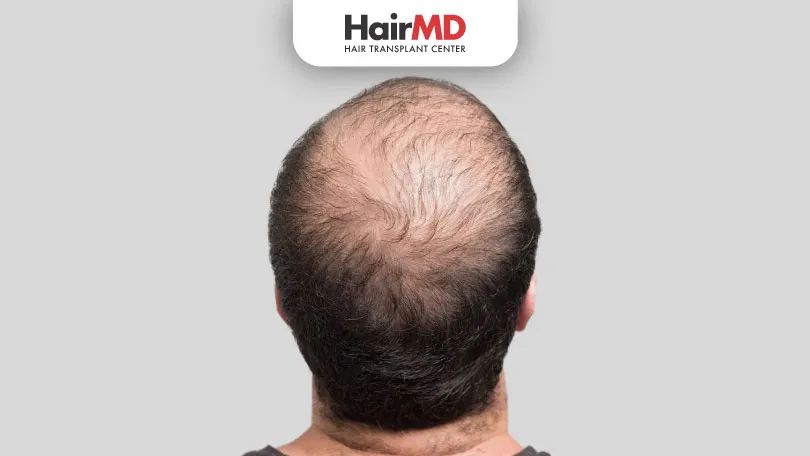2nd Sept, 2023

What’s covered in the article?
- What is Male Pattern Baldness?
- Male Pattern Baldness: Causes And Risk Factors
- Who is At Risk of Male Pattern Baldness?
- Symptoms of Male Pattern Baldness
- 7 Stages of Male Pattern Baldness
- Diagnosis For Male Pattern Baldness
- 5 Common Male Pattern Baldness Treatment Options
- Natural Remedies for Male Pattern Baldness
- Food Intake to Prevent Hair Loss
- When to Consult a Doctor?
- Why Choose HairMD?
- Conclusion
What is Male Pattern Baldness?
Male pattern baldness, also known as androgenic alopecia, is a very common hair loss problem in men. According to studies, almost 50 percent of men over the age of 50 will experience male pattern baldness.
Male Pattern Baldness: Causes And Risk Factors
One of the significant causes of baldness is genetics, that is, having a family history of baldness. Research has shown that male pattern baldness is a result of sex hormones called androgens, which include functions like regulating hair growth. Every hair strand on your head has a life cycle, and with men’s baldness, the growth cycle gets weak over time. The hair follicle starts to shrink and it produces short and fine strands of hair. Over time, the growth cycle for every strand ends, and there is no new hair to replace the ones lost.
Who is At Risk of Male Pattern Baldness?
Although male pattern baldness stages can start as early as your teenage years, it commonly occurs in adult men. The intensity of male pattern baldness can increase with age, which is why genetics plays a major role. Men who have relatives with this problem are vulnerable to go bald; especially on the maternal side of their family. Research has shown that genetics are not the only reason for baldness in males. Other factors like smoking, stress, and polluted environments can be just as big of a reason.
Symptoms of Male Pattern Baldness
The initial signs of pattern baldness is a receding hairline, the hair loss will start at the temples and the crown areas on your head. Some men will start noticing a single bald spot on the vertex, while others will notice the receding hairline that will form an “M” shape. Sometimes, men will start experiencing a receding hairline, until all the hair is gone.
7 Stages of Male Pattern Baldness
As mentioned earlier, various types of male pattern baldness include receding hairlines that forms an ‘M’ shape. Eventually, the hair loss will increase and the growth will get finer, shorter, and weaker. It will progress to balding in the back of the head, which will create a horseshoe-type pattern around the sides of the head.
Stage 1:
Since the hair thinning around the temple stage is subtle, the early-stage male pattern baldness can be difficult to identify. So, one should stay vigilant – especially if the problem runs in their family. The moment you see subtle red flags, you can try out natural remedies like applying oil to your hair to strengthen its roots.
Stage 2:
This is where the receding hairline gets more evident and the forehead becomes prominent. The receding hairline will create an “M” shaped hairline.
Stage 3:
This is where balding increases and the hair at the top of the scalp becomes finer and weaker. Old hair strands start falling off, and no new growth replaces them. The bald spots get more visible during this stage.
Stage 4:
This pretty much solidifies male pattern baldness because you will end up losing a lot of hair. The bald spots increase, and the hair on the crown and the back of the head start thinning out
Stage 5:
This is where the U-shaped hairline starts to appear, which indicates that your male pattern baldness has significantly advanced to the latter stages.
Stage 6:
This is where your scalp is more visible, the existing hair on the head is thin and the bald patches widen. You will also experience hair loss at the sides of the head.
Stage 7:
This is where male type baldness recedes to the crown, and the existing hair is very little and the growth is sparse. If you have reached this stage it means you have lost most of your hair.
Diagnosis For Male Pattern Baldness
Diagnosing male pattern baldness includes physical examination by a doctor. They will look at your scalp to see the amount of hair you have lost and determine the stage you’re in. They will use a device called trichoscope, which views hair follicles and the space between them. There is no need for a biopsy unless the doctor suspects that the hair loss is due to a medical factor or autoimmune condition.
5 Common Male Pattern Baldness Treatment Options
Medication:
Two types of medicines are approved for treating male pattern baldness. They are minoxidil and finasteride. While the former is a topical medicine that stimulates the hair follicles to produce new growth, the latter is an oral medicine that stops your body from producing DHT responsible for thinning of hair.
Finasteride is a medicine that prevents baldness on a hormonal level. Using this medicine daily can cause hair regrowth, over time.
On the other hand, Minoxidil is a topical medicine that can increase hair growth by increasing blood flow to the scalp and stimulating the hair follicles, it doesn’t have any effect on your hormones and with consistent use, you will notice hair regrowth.
You must consult with a dermatologist before deciding on any medicines for hair loss.
Supplements and Products:
There are many supplements and non-pharmaceutical products that can slow hair loss and treat male pattern baldness. Biotin, a vitamin, is a popular hair supplement that is known to positively affect hair growth. When used in combination with something that blocks DHT, it can deliver effective results in controlling the progression of male pattern baldness. Also, many hair loss prevention shampoos are available, choosing among which can be an overwhelming experience. You should ideally look for shampoos that have ingredients like biotin, saw palmetto, and ketoconazole because they will strengthen hair follicles and promote new growth.
Other procedures
There are some hair loss treatment procedures that have become quite popular in recent times. This includes dermaroller, Platelet Rich Plasma (PRP) therapy, mesotherapy, and more. While dermaroller is a form of micro-needling that stimulates hair growth responses, PRP therapy involves injecting PRP into the scalp to prevent hair loss and promote hair growth. Mesotherapy includes injecting ingredients like vitamins, biotin and dexenol in the scalp with the objective to boost microcirculation and stimulate hair growth. Depending on your unique need, your doctor may recommend one or another, or a combination of different procedures.
Hair transplant surgery:
This is a popular male pattern baldness cure option. It includes transplanting hair from the sides and back of your head to your crown area. The hair can also be transplanted to other bald patches on your head. It restores your hairline while eliminating any other visible sign of hair loss. The procedure is performed by experienced surgeons.
Hairpieces:
While they may not grow any of your natural hair back, hairpieces and weaves do a great job at covering visible bald spots, while also providing a natural overall look. This is a quick fix if you are short on time and don’t want to go for surgery or medication
Scalp micropigmentation:
Another addition to the treatment for bald spots list is scalp micropigmentation. It is a cosmetic process that changes the pigment of your scalp and gives off an illusion of small and short hair strands. This makes it look like you have a full head of hair. However, this process only makes it look like you have hair, it does not restore the real hair strands or stimulate new hair regrowth.
How to Prevent Male Baldness?
There is no defined process that can prevent male baldness; this is especially true if the causes are genetic. However, if the problem is a result of some other external factors, there are some steps you can take to reduce hair fall.
- Take on relaxing activities like walking, painting, meditation, or listening to music
- Wash your hair with a mild shampoo
- Take vitamins
- Try oil scalp massage
- Stay hydrated
- Avoid brushing wet hair
Natural Remedies for Male Pattern Baldness
Some natural remedies that can help prevent baldness are:
- Adding herbs like Brahmi, Kumari, Ashwagandha, Japa, Tila, Lavender, and Bhringraj to your diet.
- Aromatherapy, which can improve scalp circulation. Lemongrass and rosemary oils help relieve stress as well
- Yoga moves like Sarvangasana, Bhujangasana, Kapalabhati, Anuloma viloma help with reducing hair loss.
Food Intake to Prevent Hair Loss
Here are some of the popular food items that may help prevent or reduce hair loss:
- Eggs
- Berries
- Spinach
- Fatty Fish
- Sweet potatoes
- Nuts
- Seeds
- Avocados
When to Consult a Doctor?
The best time to consult a doctor for men baldness is when you start noticing the early signs of balding. If you see the hairline has started receding, and there is a significant amount of hair fall when you shampoo or comb your hair, then it’s a good time to see a medical professional.
Why Choose HairMD?
At HairMD, we have a team of expert cosmetologists and dermatologists, as well as skilled surgeons, that ensures you get the best medical care to manage your hair loss condition. We understand that every patient is different; their needs, preferences and budgets vary. Hence, we take time to understand you, your daily routines, your lifestyle, and then draft a personalized treatment process that causes minimum stress and produces the best results.
This simple approach has helped HairMD attain a success rate of over 98.32% in hair loss treatment for men in Pune. To that, we believe in investing resources to ensure that our clients have access to the best and innovative facilities in their hair loss treatment. Our in-house medical team is constantly looking at avenues to make the treatment process more efficient, comfortable, and cost-effective. Contact us today for more information.
Do You Know?
Nearly 250 Patients Visit HairMD
Everyday For Various Hair Concerns?
(You are one click away from flawless skin)
Meet Our Dermatologists
Conclusion
Further Reading
How to Stop Hair Shedding After an Accident?
Explore the effects of trauma on hair, treatments, and tips for recovery and regrowth after a stressful incident.
Understanding Hair Transplant Results: Simple Guide for Patients
Explore hair transplant results, recovery phases, regrowth, & post-care tips to achieve natural-looking results. expert advice at HairMD
Is Hair Transplant Right for You? | Guide for Patients
Discover hair transplant methods, eligibility for the procedure, and key tips for successful hair restoration from HairMD.
Know the Benefits of Mesotherapy for Hair Loss
Learn how mesotherapy helps treat hair loss and promotes healthier, thicker hair!
Have thoughts? Please let us know
We are committed not only to treating you, but also educating you.











